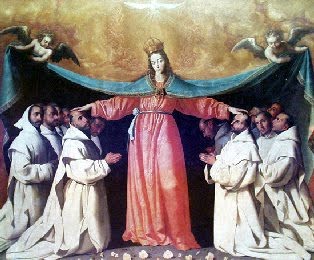 ‘Undecim discipuli abierunt in Galilæam, in montem ubi constituerat illis Iesus, et videntes eum adoraverunt – The eleven disciples went into Galilee, to the mountain which Jesus had appointed them, and seeing Him they adored’ (Saint Matthew 28:16-17).
‘Undecim discipuli abierunt in Galilæam, in montem ubi constituerat illis Iesus, et videntes eum adoraverunt – The eleven disciples went into Galilee, to the mountain which Jesus had appointed them, and seeing Him they adored’ (Saint Matthew 28:16-17).Quite often a mountain is symbolic of problems, obstacles to overcome: ‘If you have faith as a grain of mustard seed, you shall say to this mountain move from here to there, and it shall move’ (Saint Matthew 17:20).
But throughout Sacred Scripture a mountain is also where man encounters Almighty God. It was at a mountain that Abraham built an altar and called upon the Name of the Lord (cf. Genesis 12:8). Interiorly, for a people of prayer, the altar of sacrifice has already been built – it is the human heart – its stoniness has been removed and replaced with a natural heart, infused with the Holy Spirit (cf. Ezekiel 36:26-27).
When the king of Sodom and the king Gomorrah were overthrown, those that remained fled to the mountain (cf. Genesis 14:10). Thus the mountain is a place of refuge. A place of refuge can be a church building or chapel where Jesus in the Blessed Sacrament waits for those seeking divine intimacy. But Jesus tells us that our room is also a place where we can go and pray to our Father in secret (cf. Matthew 6:6). There’s really no distinction as to what room one can use: the Latin word used is cubiculum which can mean bedroom, living room – any room. Wherever one chooses exteriorly to seek the Lord, one hopes to enter into that inner refuge, that interior sanctuary, where God: Father, Son, and Holy Spirit are hidden, are in secret. In fact, a fifteenth-century reflection from a Carthusian monk at Nuremberg refers to the Sacred Heart of Jesus as the City of Refuge, an ‘inexhaustible fountain of love and grace’.
Lot was told to flee to the mountain, that he may be spared from the destruction of Sodom and Gomorrah (cf. Genesis 19:17). Again, the mountain is depicted as a place of safety, security, a place of refuge. Interiorly it is where heart enters into Heart.
On the mountain, the inner Tabernacle, where one encounters the living God, one also listens in silence for gentle whispers, movements which only the heart can translate. Whispers which have answers, whispers that encourage, whispers that teach. Moses encounters God on the mountain. Moses received instructions from God on the mountain. Moses received the Law on the mountain. Jesus taught on the Mount of Beatitudes. Three apostles prostrated themselves on the Mountain of Transfiguration, where there appeared to them the Law and the Prophets, and He Who is Lord of the Law and the fulfilment of prophecy. And let us not forget that Jesus Himself would go to the mountain to pray, delineating that very great mystery of the perpetual communion of the Most Holy Trinity.
Scripture asks: ‘Who shall ascend into the mountain of the Lord’ (Psalm 23 [24]:3). Great is the Lord and exceedingly to be praised in His holy mountain (cf. Psalm 47 [48]:2).
‘Come, let us go up to the mountain of the Lord. . . and He will teach us His ways and we will walk in His paths’ (Isaiah 2:3). May our Blessed Lady, our Lord’s chosen dwelling-place before entering into the world, teach us to keep the Word in our hearts, pondering Him always (cf. Saint Luke 2:19).











